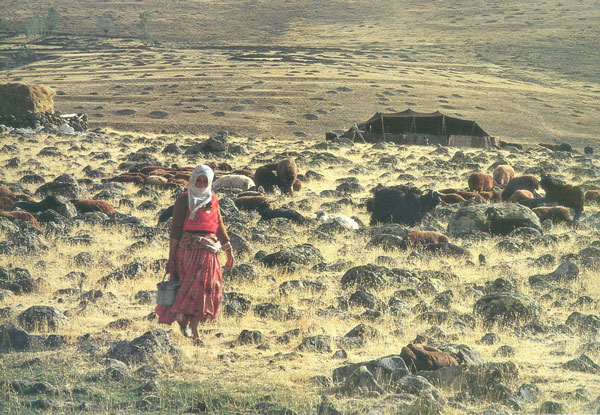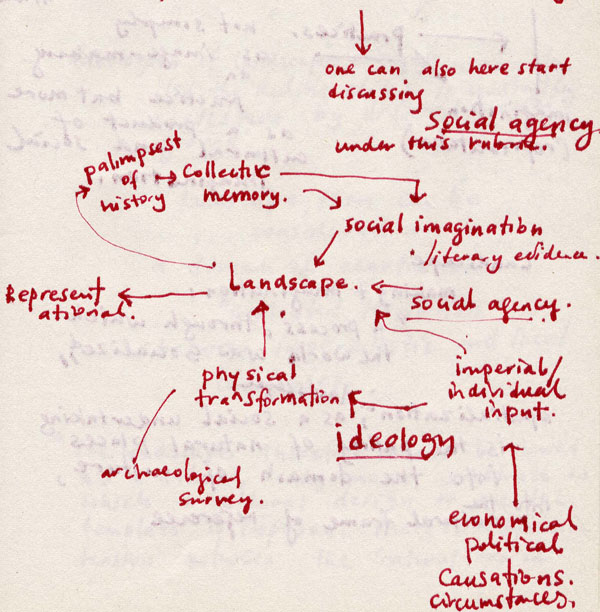"In the beginning was the Topos. Before - long before - the advent of the Logos, in the chiaroscuro realm of primitive life, lived experience already possessed its internal rationality; this experience was producing long before thought space, and spatial thought, began reproducing the projection, explosion, image and the orientation of the body. Long before space, as perceived by and for the 'I', began to appear as split and divided, as a realm of merely virtual or deferred tensions and contacts. Long before space emerged as a medium of far-off possibilities, as the locus of potentiality. For, long before the analysing, separating intellect, long before formal knowledge, there was an intelligence of the body."
Henri Lefebvre, The Production of Space. 1991: 174.
"The lived body allows us to know what space, place and landscape are, because it is the author of them all."
Christopher Tilley, The materiality of stone 2004: 3.
One of the fascinating points that Tim Ingold makes in his "Temporality of Landscape" is that human bodily engagement with the world is better described not as an "inscription" of the living body onto the material world, but rather a phenomenon of in-corp-oration- suggesting a deep embedding of the human body in the world. Ingold poetically describes this when he defines the landscape as "the world as it is known to those who dwell therein, who inhabit its places and journey along the paths connecting them" (156). This brings in, on the one hand, the idea of a landscape as taskscape: we inhabit the world through our technologies of building and dwelling (as Heidegger would have put it)- through a laborous engagement with the world. I shall relate this notion to Henri Lefebvre's concept of space being a "social product" where product carries all the loaded meanings and economic connotations of "work" and tangible production. However what is very significant here is that I am cautious not to approach social constructionism where such productive work is usually grasped as discursive and therefore necessarily ideological. The second part of Henri Lefebvre's dictum is that this act is a collective one- which in my opinion can hardly be contested.
Landscape, then, is the real world that unfolds with the above-discussed processes of embodiment. Our relationship to landscape is always like Michel de Certeau's wanderers or Walter Benjamin's flaneur- truly immersed in the making of the world through our spatial practices such as "walking". As Ingold argues, "the notion that we can stand aside and observe the passage of time is founded upon the illusion of disembodiment" -which reminds one the Enlightenment idea of perspective where the artist/architect has to pull him/herself out of the landscape to be able to depict it. This surveillance position is the imperialist position of the colonizer, or the viewer of Manhattan from the 118th floor of WTC (which is now ironically a ruin) in De Certeau's The Practice of Everyday Life. This idea then prepares me to argue that archaeological and ethnographic field practices of the past that intended to adopt such a "surveying" vision of the landscape typically failed to engage with places and the place-world, precisely because places are invisible, ungraspable to the imperialist vision. Here emerges the exciting idea that archaeological and ethnographic can be viewed as place-making practices, as I tried to explain with the example of the Neolithic mound of Erbaba near Beysehir Lake. Archaeologists and ethnographers are not simply onlookers, they are makers of the place-world.
 | Haptic way of knowing refers to a corporeally formed body of knowledge about the world. Knowledge of the world is irreducable to a mental exercise - memories are formed through bodily practices. "The word haptic, from a Greek term meaning to lay hold of, is used to describe the various sensibilities of the body to its position in the physical environment and to its own condition." (O'Neill 2001:3-4). This multi-sensory emphasis on the experience of landscape resists representations of the world largely in verbal or visual form - but invites considerations of olfactory, tactile, kinesthetic and aural aspects of a practiced place-world. But even this Marleau-Pontian, |
phenomenological view seems to be rather reductive when one imagines the local sedimentation of local geologies on the body and in the body.
Then is it possible to say that a place-oriented field research must face "the thick concreteness of a given place". In many ways, archaeologists and ethnographers have long been practicing such virtuosity of engaging with places in rich and complex ways. However in the publications such intimate stories of field practice are edited out for the sake of positivism and scientism, and archaeological sites are transformed into islands of historic preservation, "non-places" so to speak, fenced off from their everyday and social environment, surveyed through multiple technologies of surveillance. This we shall call "disruptive islanding" - a primary concern for the ethnographer of archaeological practice. For the Hittite spring site of Eflatunpinar by Beysehir Lake, there are rumors today for a plan to empty out the pool, channel the spring elsewhere and replace the original blocks with replicas, and move the monument to a museum, fence the site, and charge a fee for entering the site. This would create in a way precisey the typle of "non-places" that Marc Auge has written about.
Bibliography
- Ingold, Tim; 1993. "Temporality of landscape" World Archaeology 25/2: 152-174.
- O’Neill, Máire Eithne; 2001. “
 Corporeal experience: A haptic way of knowing,” Journal of Architectural Eduation 55:3-12.
Corporeal experience: A haptic way of knowing,” Journal of Architectural Eduation 55:3-12.

